Magic 8 Balls are, essentially, a tool for Fortune-Telling, or Divination.
Are there other alternatives to a Magic 8 Ball for the purpose of Fortune-Telling? Yes, there are! Throughout history, men have devised numerous simple and complicated ways of predicting the future. In this article, we will explain X different ways to get the answers you need, when you don’t have your Magic 8 Ball at hand!
Will you meet a tall, dark stranger or win the lottery? Well, only time will tell. Or maybe one of our 5 different techniques to get answers.
But, what is Fortune-Telling?
Study indicates that Fortune-Telling has been in practice for over a 1000 years since the ancient times in China, Egypt and Babylonia, as a part of their religious and medical practices. It is, essentially, the forecasting of future events, by use of a method that has no rational explanation.
In modern day, fortune-telling also refers to easily recognizable terms such as astrology, the interpretation of the movements of heavenly bodies as influences on earthly events, numerology, more experimental forms, such as graphology, the study of handwriting, physiognomy, the study of facial characteristics, and palmistry, the study of lines on the palm of the hand. Fortune-telling can also take up more diverse forms of practices such as the utilization of objects to tell the future, such as with playing cards, Turkish have a method of reading with their tea leaves that are left in a cup after it has been drunk, crystal balls, dice, fire, water and even scattered salt.
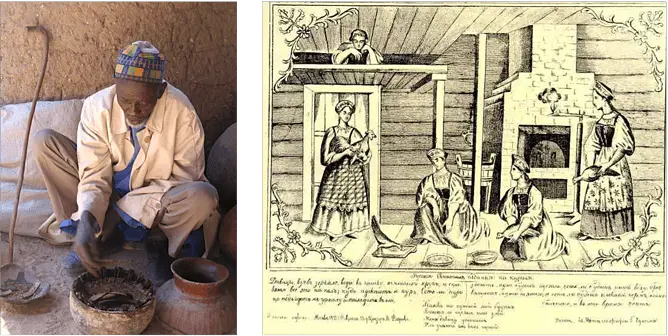
Fortune-telling is more an everyday practice for personal purposes. When any of the above are used in a more formal or ritualistic manner, often with more of a social character, usually in a religious context, it is called Divination. For example, the man in the picture on the left, in Rhumsiki, Cameron, attempts to do fortune-telling by observing the changes in the position of a freshwater crab. In the picture on the left, 19th century Russian peasant girls using chickens for divination.
Interestingly, the founder of the very first Magic 8 Ball (he called it the Syco-Seer: The Miracle Home Fortune Teller) in 1946 was Albert C. Carter, who was inspired by his mother who was clairvoyant and used an oracle ball to get answers from the other world to predict and read the future and past.
What alternative forms of Fortune-telling can you use today?
While the Magic 8 Ball is everyone’s absolute favourite, there are a lot of different, ingenious alternatives to it for you to get answers to all your questions. We will talk about X of the inspiring and most experimental, fun ones here.
1. Ouija Boards
Henry Handel Richardson (H.H.R.) was the pen name of Ethel Florence Richardson (1870-1946), the founder of the original Ouija board – now easily available across shops and online stores. She believed in the afterlife and claimed not to mourn because she was always in contact with deceased loved ones.
The word Ouija has roots in the word yes in French and German, specifically, oui and ja.
The game is as simple as the Magic 8 Ball, with a board with printed letters and numbers, and hand-sized device (planchette) that can be slided over the board. Although, you guide the planchette with your hands, the belief is that a supernatural power guides you as you control it and move it across the board. You ask it a question and then move it, answering the question by spelling out with letter and/or numbers.
There are, now, a number of varieties of the Ouija Board. The original one is shown in the picture above with the basic letters, numbers and symbols of the sun and moon. There are varieties with themed answers and even with Magic 8 Ball inspired replies.
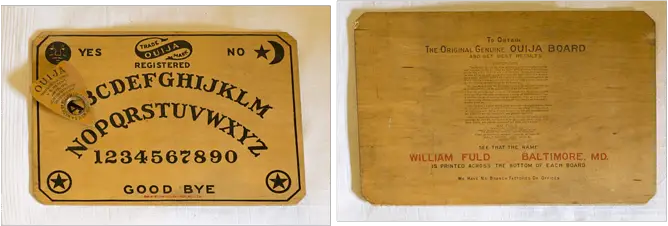
2. Tarot Cards
Tarot card reading is a form of fortune-telling whereby practitioners use tarot cards to answer a question by gaining insight into the past, present or future. It is believed that tarot card reading originated from Egypt and India, but its use dates back many centuries back as far as Europe. Today’s standard tarot deck consists of 78 cards divided into the Major Arcana (22 cards = interpreting major life event issues) and the Minor Arcana (56 cards = interpreting less significant and daily life event issues).
The cards have a chronological order depicting major and minor themes occurring over time, and each one has its significant meaning. They cannot be interpreted without an experienced Tarot card reader, who then interprets the meaning of the card (or set of cards) as an answer to the asked question. Now, there are also online websites for Tarot Card reading, try at your own risk!
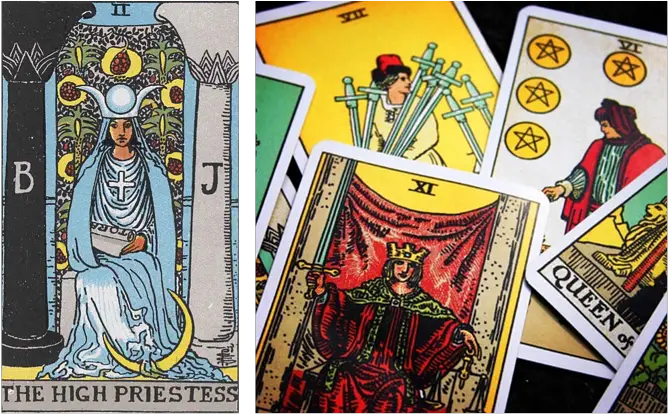
3. Palmistry
Palmistry is the reading of character and future of a person through the line and undulations on the palm of his hand. The origins of palmistry are a bit uncertain. It may have begun in Ancient India, but has been seen throughout times in China, Tibet, Persia, Mesopotamia, Egypt and even Greece.
Palm-Readers believe in reading both the right and left palm of a hand for accurate analysis. The non-dominant hand (left or right) reveals your inert personality, while the dominant (right or left) shows their practice in your everyday life.
Together, they reveal how a person is utilizing their potential in this lifetime. The different lines on both hands indicate aspects such as your health, life, love etc. While there are many apps and websites that do your palm reading for you, its most exciting when you go to a reader physically!
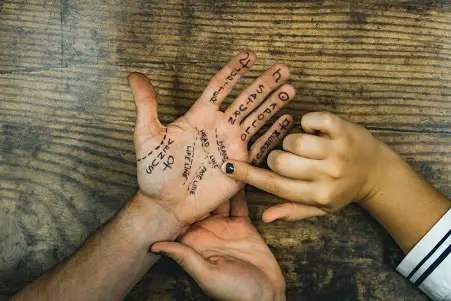
4. Flipism
Flipism is possibly the most interesting alternative in our list. It is a pseudo philosophy – meaning you make decisions with the flip of a coin. It originates from a Donald Duck comic, with the name, Flip Decision, by Carl Banks in 1953.
What started with a cartoon now has a massive following of fans and believers. While Donald Duck used a coin, a real coin is not absolutely required. Any kind of answer generator, online or in real life such as a 6 or more sided dice, can also be used. The idea is for the generator to have two or more options for answers that can appear upon asking it a question, as long as the meaning of each side/option/possibility has been pre-determined.
According to a study published in The Review of Economic Studies by scientists at the University of Chicago, making decisions based on the flip of a coin could help you live a happier life. According to the research, decisions made with a coin toss are more likely to happen. There is more life (and decision) satisfaction, and a longer oberall happiness over a six-month period after the decision, even if it is with significant decisions, such as moving cities or restarting your career, based on the flip of a coin.
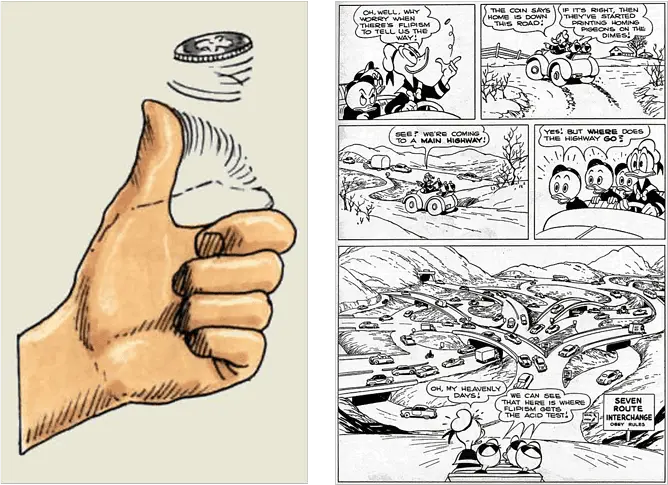
5. Tasseography
Tea leaves have been used throughout history as a fortune-telling tool to explore the past, present and future of a person. It is most commonly practiced in Turkey, India and Japan – countries that are essentially more tea drinking nations.
Tasseography is a creative method of identifying symbols to infer messages found in the organic formations of tea leaves left in a cup after a drink. The concept relies on supernatural energies directing the configurations and patterns of the tea leaves. Like all other methods, it also relies heavily on the magical intentions of the practitioner to direct the process and read the mystical messages.
For those interested, A Beginner’s Guide to Tasseography, or the Art of Tea Leaf Reading by Jessica R. Anderson, is a book available on Amazon that provides readers with a comprehensive guide to symbols, as well as tips and techniques to tap into your own intuition and interpret hidden messages in the bottom of your cup!
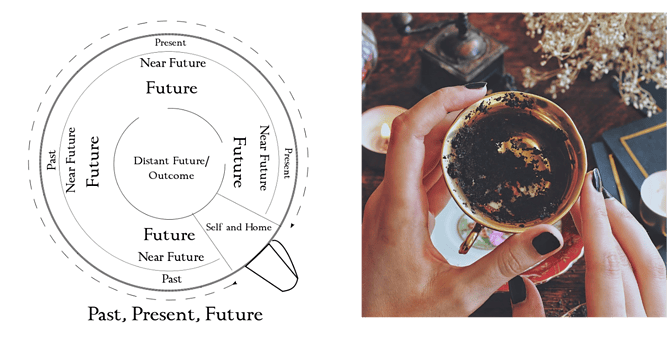
Conclusion
There are a lot of different studies on each one of these fascinating alternatives. There are some strict followers and others that do not so much. At the end of the day, divination is not much about the psychology of any of the methods but the person who consciously decides to use one of them to ask a question. it strengthens the fact that we need something tangible to reassure our gut and our instincts.
Everything is conscious. You can will a sign for any event, just wait for an answer, and find guidance from everything around you.
References
Reference 1: Psychic Living: A Complete Guide to Enhancing Your Life, by Stacey Wolf
Reference 2: Field Guide to Luck: How to Use and Interpret Charms, Signs, and Superstitions, by Alys R. Yablon
Reference 3: Britannica – Fortune Telling https://www.britannica.com/topic/fortune-telling
Reference 4: Ouija Board: Demystifying the ‘Mystifying Oracle’ https://www.livescience.com/41859-ouija-board.html
Reference 5 – All The Ways You’ve Already Predicted Your Fortune https://www.bustle.com/articles/29320-magic-8-balls-ouija-boards-and-6-more-totally-inaccurate-fortune-telling-methods-we-loved-as
Reference 6: Tarot Card Reading https://en.wikipedia.org/wiki/Tarot_card_reading#:~:text=Tarot%20card%20reading%20is%20a,interpret%20them%20for%20this%20end.
Reference 7: What is a Tarot Card Reading and How Does It Work?
Reference 8: Palmistry https://www.britannica.com/topic/palmistry
Reference 9: Heads or Tails: The Impact of a Coin Toss on Major Life Decisions and Subsequent Happiness. Published by Oxford University Press on behalf of The Review of Economic Studies Limited in 2020
https://www.gwern.net/docs/psychology/2020-levitt.pdf
Reference 10: Tasseography – The Art of Tea Leaf Reading by Jessica R. Anderson
Figure 2 – Left, a man in Cameroon, performing a Divination practice by predicting the changes in the position of various objects, as casued by freshwater crabs. Right, 19th Centurry Russian peasant girls using chickens for Divination
Figure 3 – An Ouija Board https://www.nationaltrust.org.au/collections/ouija-board/
Figure 4 – A fortune-teller conducting a palm reading, with lines and mounts marked out on the person’s left palm https://en.wikipedia.org/wiki/Palmistry
Figure 5 – Left, Flipisim refers to the the flip of a coin. Right, the Original Donald Duck Cartoon it appeared on in 1953.
Figure 6 – Tea leaves reading can be fascinating!
